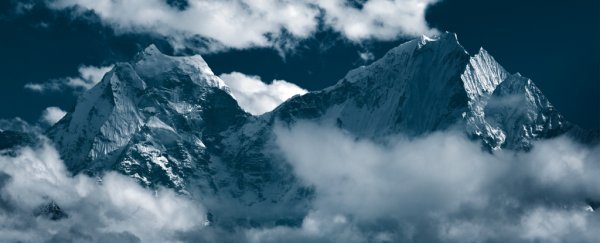HP Lovecraft may be a polarising figure nowadays, but he was right about one thing: there's madness in them thar mountains. And now researchers have determined a new medical entity, discrete from altitude sickness, that causes it.
They're calling it high-altitude psychosis, and it occurs at altitudes of over 7,000 metres (23,000 feet) - often manifesting as extreme hallucinations.
There have been many documented cases of mountaineers experiencing psychotic episodes at extreme altitudes.
Visual and auditory hallucinations are common, such as movement where there is none, or hearing human voices or music, and climbing alone seems to exacerbate the phenomenon.
And there's one type of somesthetic illusion that is so common it has its own name - the Third Man factor.
This is when the person feels like someone is climbing with them, and it's not unique to mountain climbing, as evidenced by Sir Ernest Shackleton's report of the phenomenon when traversing Antarctica in 1914.
Nevertheless, these hallucinations have for years been ascribed to severe altitude sickness, when the body ascends too rapidly to become accustomed to the lower oxygen available at high altitudes.
Symptoms include headache, lethargy, clumsiness, dizziness, nausea, insomnia, bleeding in the eyes, and, in extreme cases, excess fluid in the brain and lungs.
It is this cerebral oedema that had been thought responsible for both physical symptoms such as dizziness, lack of balance and headaches, as well as the hallucinations.
But now a team of researchers from Eurac Research in Italy and the Medical University of Innsbruck in Austria have put forward that the hallucinations are a separate condition.

They examined 83 reports of psychotic episodes from German-language scientific articles on mountain climbing and analysed the symptoms thereof.
"In our study we found that there was a group of symptoms which are purely psychotic," said Hermann Brugger, head of the Institute of Mountain Emergency Medicine at Eurac Research.
"That is to say, that although they are indeed linked to altitude, they cannot be ascribed to a high-altitude cerebral oedema, nor to other organic factors such as fluid loss, infections or organic diseases."
They researchers are not entirely sure why the hallucinations occur.
Hypoxia could certainly play a role, or the early stages of brain swelling. Or even being alone or in a very small group in very tough conditions (which would be consistent with the other situations in which the Third Man appears).
What is known is that, once the person is back at a safe altitude, the symptoms disappear, and there are no long-lasting effects.
"This discovery has allowed us to make a more thorough investigation of temporary psychoses in otherwise completely healthy people, an investigation which might yield important indications for the understanding of psychiatric diseases such as schizophrenia," said co-author Katharina Hüfner of the Medical University of Innsbruck.
The finding may also be able to help mountaineers better prepare for their time in high altitudes, and formulate strategies if they do find themselves afflicted by high-altitude psychosis.
And researchers can try to replicate the results in a laboratory setting - such as low-oxygen and low air pressure chambers.
The team is also preparing to collaborate with Nepalese doctors next year to try and get a more accurate assessment of how often high-altitude psychosis occurs, as well as potential risk and trigger factors.
The research has been published in the journal Psychological Medicine.
